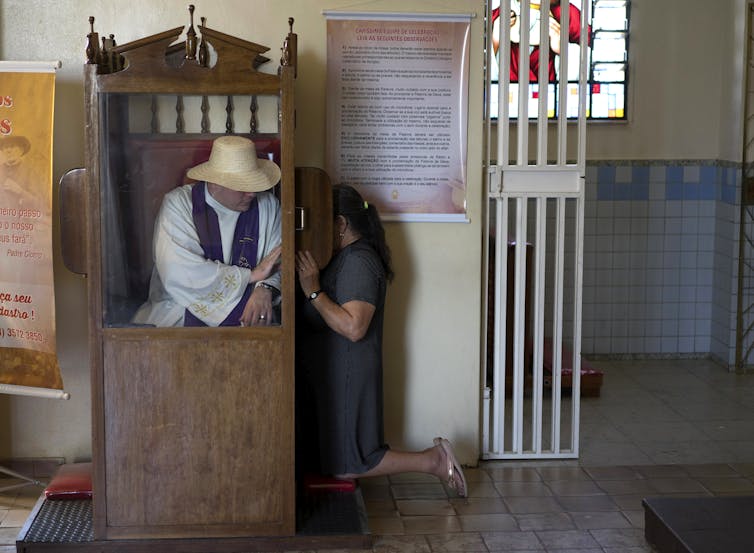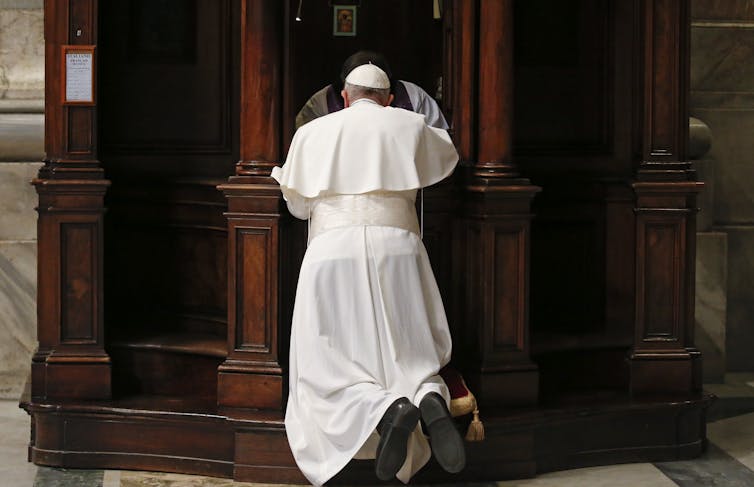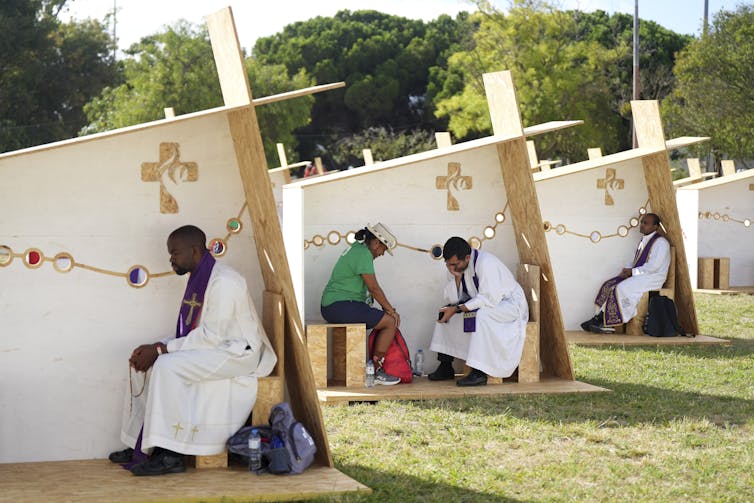From public confession to private penance: How Catholic confession has evolved over centuries
The Catholic Church treats information shared during confession as absolutely confidential – but that requirement can create legal dilemmas.

The 1953 Alfred Hitchcock film “I Confess,” based on an earlier play, features a priest suspected of murder. He’s innocent, and has even heard the murderer’s confession – but cannot clear his own name.
The Catholic sacrament of reconciliation, also known as penance or confession, has been a compelling set piece for fiction writers over the ages, from medieval novels to contemporary films. One reason the practice has intrigued both authors and audiences is the dramatic potential of the “seal of the confessional” – that is, the requirement that priests not disclose any identifying information about what they have heard during confession.
Recently, this sacrament has garnered nonfictional attention. Washington state passed a law on reporting child abuse, which was scheduled to go into effect in July 2025. In some circumstances, the law requires clergy to report abuse or neglect, even if it is revealed during confession. On July 18, however, a federal judge put the law on hold, amid a lawsuit alleging the measure would violate First Amendment rights to religious freedom.
But what is the sacrament of reconciliation, and how has the practice developed in the Catholic Church?
‘I have sinned’
Today, the most common form of confession takes place between a penitent and the “minister of the sacrament” – a priest or bishop. There may be a screen between the two, or they may sit across from one another without anonymity.

At the beginning of the rite, the minister greets the penitent “with kindness,” offers a prayer and sometimes reads from the Bible.
The penitent then confesses the sins they believe they have committed since their last visit. In Catholic teaching, a sin is defined as a failure in loving God and others properly.
Christians believe that sin distances humans from God, but that Jesus’ life, death and resurrection repaired that wounded relationship. The confessor – the ordained clergy hearing the confession – reminds the penitent that through the sacrament, they participate in this central mystery of faith.
Following the confession, the priest or bishop proposes an act of penance: a prayer or action by which the penitent might grow in holiness and make amends. Afterward, the penitent offers a prayer of contrition, asking for God’s mercy. The confessor then absolves the penitent in the name of God before exclaiming, “The Lord has forgiven your sins,” and dismissing the penitent to “Go in peace.”
History of the sacrament
Confession is a form of repentance: turning away from wrongdoing and heeding the call of God, a theme long emphasized in the Jewish and Christian traditions. While still an important emphasis today for Jews and Christians, practices around repentance vary.
In the Catholic tradition, baptism – the first sacrament a person receives – washes away sin and brings the baptized into the church. As Jesus’ apostle Peter says in the New Testament, “Repent and be baptized every one of you in the name of Jesus Christ so that your sins may be forgiven, and you will receive the gift of the Holy Spirit.”

Gradually, the church developed communal practices for reconciliation after baptism. Typically, penitents would remain outside church gatherings, demonstrating their repentance by prostrating themselves, and then publicly confess. Though the historical record is complex, communal penance usually could be undertaken only once.
In an important variation, medieval soldiers returning from war regularly spent an extended period of penance in monasteries – a recognition of Catholicism’s teaching that any war is inherently sinful.
During the Middle Ages, the practice of individual confession developed in what is now Ireland. The rite introduced private confession to a priest, who ritually represents both Christ and the wider church. Eventually, this rite became repeatable.
Individual confession was codified into church law at the Fourth Lateran Council, a meeting of bishops in 1215. The council also emphasized the sanctity of the seal of confession – that is, clergy’s requirement not to “betray” a penitent by revealing something confessed to them during the sacrament of reconciliation.
This absolute confidentiality helps give penitents the confidence to approach confession forthrightly, without holding back. The automatic consequence for a confessor who breaks the seal of confession is excommunication – that is, banned, at least temporarily, from the sacraments of the church. In some cases, the offender can be removed from the clergy.
Public and private
Two elements of confession are emphasized throughout Christian history, sometimes in a kind of back-and-forth: interior attitude of repentance, and outward expression of that repentance. Catholicism teaches that speaking aloud one’s sins makes them concrete in a way that private prayer cannot – and makes the forgiveness concrete, as well. As Pope John Paul II wrote, confession “forces sin out of the secret of the heart and thus out of the area of pure individuality, emphasizing its social character as well.”

In the standard form of the Catholic sacrament today, the communal element is reduced but not lost, since the confessor stands in for the presence of Christ and for the presence of the wider Christian community. Other penitential acts bring the communal aspect more to the fore. Indeed, at every Catholic Mass, participants offer a general confession of sins without specifying particular actions. They ask for each other’s prayers, and pray for God’s forgiveness.
The sacrament of reconciliation, however, remains a practice in which Catholics can be specific and concrete about what they understand to be serious sins. Dorothy Day, an American peace and labor activist who is under consideration for sainthood, famously reflected that “confession is hard. … You do not want to make too much of your constant imperfections and venial sins, but you want to drag them out to the light of day as the first step in getting rid of them.”
At its best, the sacrament of reconciliation aims to support this practice and bring about God’s abundant grace upon the penitent.
Timothy Gabrielli does not work for, consult, own shares in or receive funding from any company or organization that would benefit from this article, and has disclosed no relevant affiliations beyond their academic appointment.
Read These Next
West Coast levee failures show growing risks from America’s aging flood defenses
Levees protect more than 7 million buildings in the US today, yet they got a D-plus grade in 2025. A…
LA fires showed how much neighborliness matters for wildfire safety – schools can do much more to te
Managing fire risk is about more than regulations and rules. It’s also about caring for neighbors…
Has the Fed fixed the economy yet? And other burning economic questions for 2026
As 2026 begins, uncertainty is at the top of everyone’s mind.






